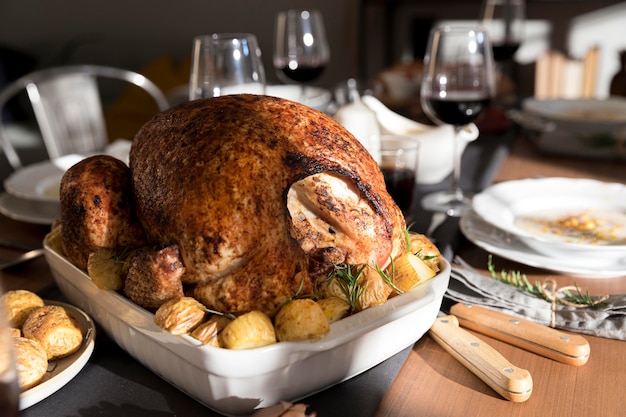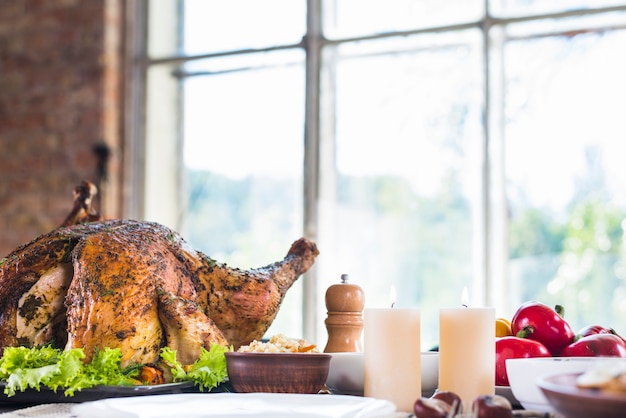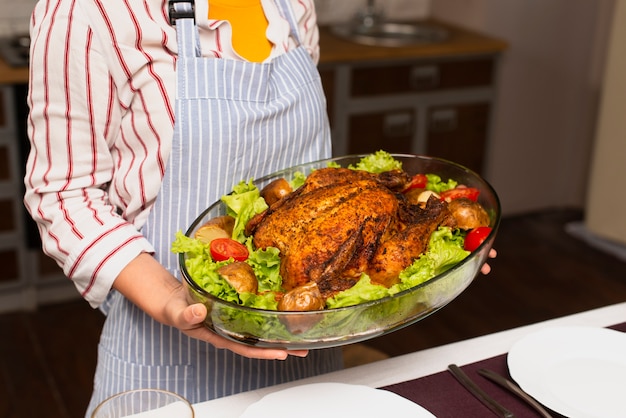You've got a magnificent 17lb turkey, the star of your festive feast. The anticipation is building, but a crucial question hangs in the air: just how long does it take to cook this majestic bird? Let me tell you, I’ve been there. I’ve tackled turkeys of all shapes and sizes, from little birds perfect for a cosy dinner to behemoths that could feed an army. Today, I'm going to share my insider knowledge, helping you master the art of turkey roasting and ensure your bird is cooked to juicy, golden-brown perfection.
We'll explore the science behind turkey cooking, debunk some common myths, and arm you with tips and tricks that will have everyone raving about your culinary skills. So grab a comfy chair, a mug of something warm, and let’s dive into the world of turkey cooking times, together.
(Part 1) The Basics: Understanding Turkey Cook Times

First, let’s set the stage. The cooking time for a 17lb turkey isn’t a one-size-fits-all situation. It depends on a few key factors that we need to consider:
Size of the Turkey:
Imagine your turkey as a fluffy cloud, the bigger it is, the longer it takes to bake. A 17lb turkey will need significantly more time to cook through compared to a 10lb bird. Don’t worry, we’ll unpack a precise formula for calculating cooking time based on weight later in the article.
Roasting Method:
You might be a conventional oven kind of person, or you could be a fan of the fan-assisted method. Maybe you’re even adventurous and want to try roasting in a bag or using a pressure cooker. Each method comes with its own quirks and impacts the cooking time, so we’ll need to tailor our approach to match your chosen roasting style.
Your Oven's Personality:
Just like people, ovens have personalities. Some are fiery and quick to heat up, while others are slow and steady, taking their time. To understand your oven's temperament, invest in a good oven thermometer. This little tool will give you an accurate temperature reading, ensuring your turkey is cooking at the right heat, which is absolutely crucial for consistent results.
(Part 2) The Science of Turkey Cooking: A Deeper Dive

Let’s get a little scientific and explore what happens when a turkey meets the heat of the oven. It’s not just about throwing a bird in and hoping for the best. There's a fascinating process at work that affects the texture and flavour of your turkey.
Meat Protein: The Building Blocks
Think of a turkey as a complex masterpiece made up of protein molecules. These molecules are like tiny threads, intertwined to form the structure of the meat. When you heat the turkey, these threads start to unravel and re-form into new bonds, creating a tighter, more solid texture. This process is called denaturation, and it's what gives cooked meat its characteristic firmness and texture.
Temperature and Time: A Delicate Balance
The longer you cook the turkey and the hotter the temperature, the more the proteins denature. This leads to a more cooked, firm texture. But, here’s the catch: overcooking leads to a dry, tough bird. We want a juicy, flavorful turkey, so it's vital to monitor the internal temperature to ensure it reaches the perfect doneness point.
Safety First: Internal Temperature Rules
The USDA sets a safety guideline of 165°F (74°C) for the internal temperature of your turkey. This temperature ensures that any harmful bacteria lurking within the bird are eliminated, making it safe to eat. We always put safety first, so keep that temperature in mind as we move forward.
(Part 3) The Formula: Calculating Cook Time for a 17lb Turkey

Alright, let's get practical! How long do you need to roast that 17lb turkey? Here’s the time-tested formula, with a bit of insider knowledge to help you adjust it to your situation:
1. The Basic Formula: A Starting Point
- Unstuffed: 15 minutes per pound at 325°F (160°C).
- Stuffed: 18 minutes per pound at 325°F (160°C).
2. Adjusting for Size: The Big Bird Calculation
For a 17lb turkey, the basic formula gives us:
- Unstuffed: 17 lbs x 15 minutes/lb = 255 minutes, which is approximately 4 hours and 15 minutes.
- Stuffed: 17 lbs x 18 minutes/lb = 306 minutes, which is approximately 5 hours and 6 minutes.
3. Accounting for the Oven's Temperament: Fine-Tuning the Time
Remember, ovens are like individuals - they have unique personalities. If you’re using a fan-assisted oven, it’s a bit like giving your turkey a turbo boost! You might be able to reduce the cooking time by 15-20%. But always err on the side of caution and check the internal temperature with a meat thermometer. It’s the only way to guarantee your turkey is cooked perfectly.
(Part 4) The Temperature Check: Ensuring Doneness
We’ve got our estimated cooking time, but how do we know if our turkey is truly done? This is where the trusty meat thermometer comes in to play. It's your secret weapon for ensuring a perfect roast. Here’s how to use it:
Where to Check: The Sweet Spot
Insert the thermometer into the thickest part of the thigh, making sure it doesn’t touch any bone. The temperature should be at least 165°F (74°C).
Don't Rely Solely on Time: Trust Your Thermometer
Remember, the formula is a helpful guide, but every turkey is unique. Don't solely rely on the calculated time. Always double-check with the meat thermometer to ensure your turkey is perfectly cooked and safe to eat.
(Part 5) roasting tips: Maximizing Flavor and Juiciness
We've tackled the science, calculated the time, and got the temperature check down pat. Now, let's transform your turkey into a masterpiece of flavor and juiciness.
Brining: A Hydration Secret
Brining is like a magic potion for your turkey! It involves soaking the bird in a salt-water solution for several hours before roasting. This simple trick works wonders, as the salt draws moisture into the turkey, leaving it unbelievably juicy and flavorful.
Butter Basting: A Golden Touch
Basting your turkey regularly with melted butter is like giving it a warm hug. It helps to create a beautiful golden-brown crust and keeps the meat moist. For an extra flavour boost, add some herbs and spices to your butter, like rosemary, thyme, or sage.
Stuffing Strategy: Safe and Delicious
If you're stuffing your turkey, there’s a safe and delicious way to do it. The best practice is to stuff it right before roasting. This minimizes the risk of foodborne illness. Make sure your stuffing reaches an internal temperature of 165°F (74°C) as well, and don’t forget to cook it separately in a casserole dish if you want extra peace of mind.
(Part 6) Resting: A Crucial Step for Juiciness
After your turkey is cooked to perfection, don’t be tempted to carve it immediately. Give it a well-deserved rest for 15-20 minutes before you start slicing. This allows the juices to redistribute throughout the meat, resulting in a much more tender and succulent bird. It's a small step that makes a big difference!
(Part 7) Leftover Love: Making the Most of Your Turkey
You've triumphed over the big day, and now you're faced with a mountain of delicious turkey leftovers. Don’t fret, my friend! This is where your culinary creativity shines. There are endless possibilities for transforming those leftovers into delightful meals. Here are a few ideas to get you started:
turkey sandwiches: A Classic
The classic comfort food, perfect for a quick lunch or dinner. Slice the leftover turkey, add some cranberry sauce, stuffing, and a dollop of mayo. The possibilities are endless!
turkey soup: Warm and Hearty
A comforting and nourishing way to use up those leftovers. Combine turkey with broth, vegetables like carrots, celery, and onions, and add your favourite herbs. For a creamy finish, add a dollop of sour cream or cream.
turkey salad: Delightful and Versatile
Chop up the leftover turkey, combine it with mayonnaise, celery, onion, and a sprinkle of spices. It’s delicious on sandwiches, crackers, or even lettuce leaves for a lighter option.
(Part 8) Mistakes to Avoid: Lessons Learned from Experience
Even with all my turkey-cooking experience, I’ve made my share of blunders. Here are a few common mistakes that I've learned to avoid, so you can avoid them too.
Overcrowding the Oven: Space Matters
Make sure your oven has enough space for your turkey to cook evenly. If it’s too large for your oven, consider roasting it in sections.
Forgetting to Remove the Giblet Bag: A Crucial Step
This is a classic mistake that I've been guilty of in the past! Always remove the giblet bag from the cavity before roasting. Otherwise, you might end up with a burst bag and a messy oven.
Not Tying the Legs: Maintaining Shape
Tying the legs of your turkey together ensures that it cooks evenly and maintains its beautiful shape. Use kitchen twine or skewers to secure the legs.
Overcooking the Turkey: Avoiding Dryness
Overcooked turkey is a tragedy! Always check the internal temperature to ensure it's cooked to perfection, but be careful not to overcook.
Skipping the Resting Period: A Key to Juiciness
Remember that crucial resting period? It's not just a suggestion, it’s a vital step for maximizing the juiciness of your turkey. Don't skip it!
(Part 9) FAQs: Your Turkey Questions Answered
1. Can I freeze leftover turkey?
Absolutely! You can freeze cooked turkey for up to 4 months in an airtight container or freezer bag. Just remember to thaw it properly in the refrigerator before using it.
2. How do I know if my turkey is fully cooked?
The best way to determine if your turkey is cooked through is by checking the internal temperature with a meat thermometer. The temperature should reach 165°F (74°C) in the thickest part of the thigh, not touching any bone.
3. Can I stuff my turkey the night before?
It's best to stuff your turkey right before roasting to reduce the risk of foodborne illness. If you must stuff it ahead of time, make sure you cook it to an internal temperature of 165°F (74°C) to ensure safety.
4. What should I do if my turkey is dry?
If your turkey is a bit dry, there are a few things you can do to add moisture. You can try adding a bit of gravy or cranberry sauce to the meat. You can also try using leftover turkey in a soup or stew.
5. How do I carve a turkey?
carving a turkey is best done with a sharp carving knife. Start by removing the legs and thighs. Then, slice the breast meat into thin slices. You can also carve the wings separately.
There you have it, my friends! I hope this comprehensive guide has shed light on the art of cooking a 17lb turkey. Now, go forth and conquer your culinary challenge! Happy roasting!
Everyone is watching

How to Cook Frozen Lobster Tails Perfectly: A Step-by-Step Guide
RecipesLobster. Just the word conjures up images of lavish meals, special occasions, and a taste of luxury. But let's...

Pork Fillet Cooking Time: How Long to Cook It Perfectly
RecipesPork fillet, or tenderloin as it's sometimes called, is a real favourite in our house. It's so versatile, and...

Pigs in a Blanket Cooking Time: How Long to Bake for Perfect Results
RecipesAh, pigs in a blanket. Just the name conjures up images of those delightful little parcels of crispy pastry en...

The Ultimate Guide to Cooking Delicious Frankfurters
RecipesLet's face it, we all love a good frankfurter. It's a classic, simple, and always satisfying. But let's be rea...

Wolf Meat Recipes: A Guide to Cooking Wild Game
RecipesLet's be honest, you don't see wolf meat at your local butcher shop every day. It's a bit of a wild card, but ...
